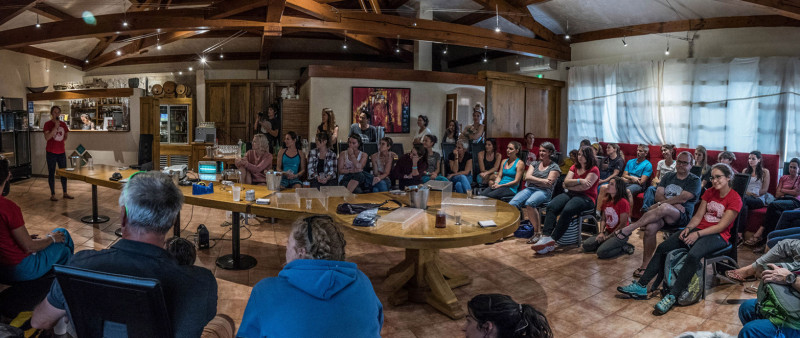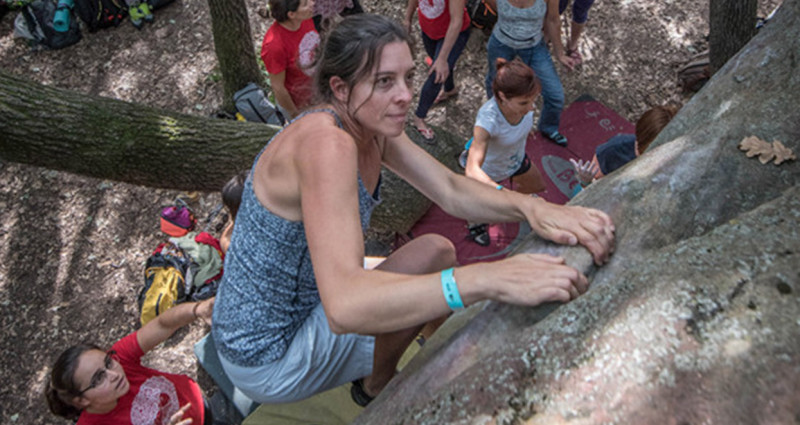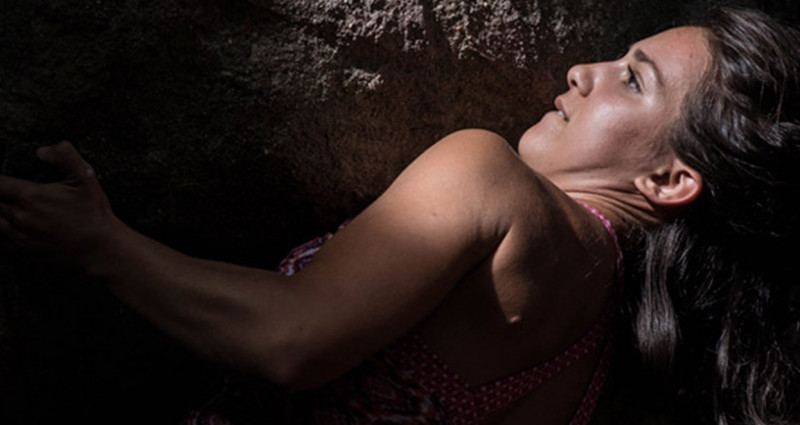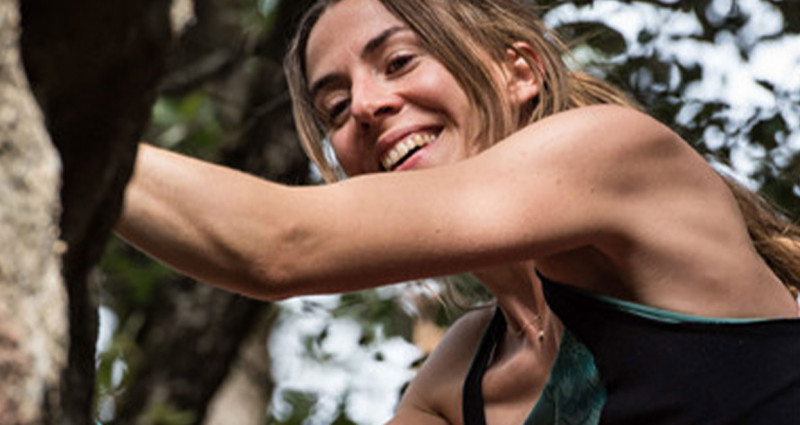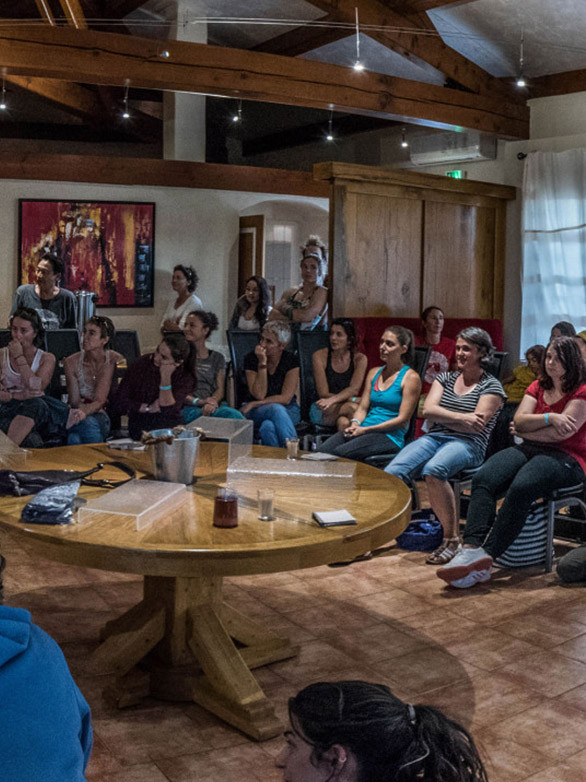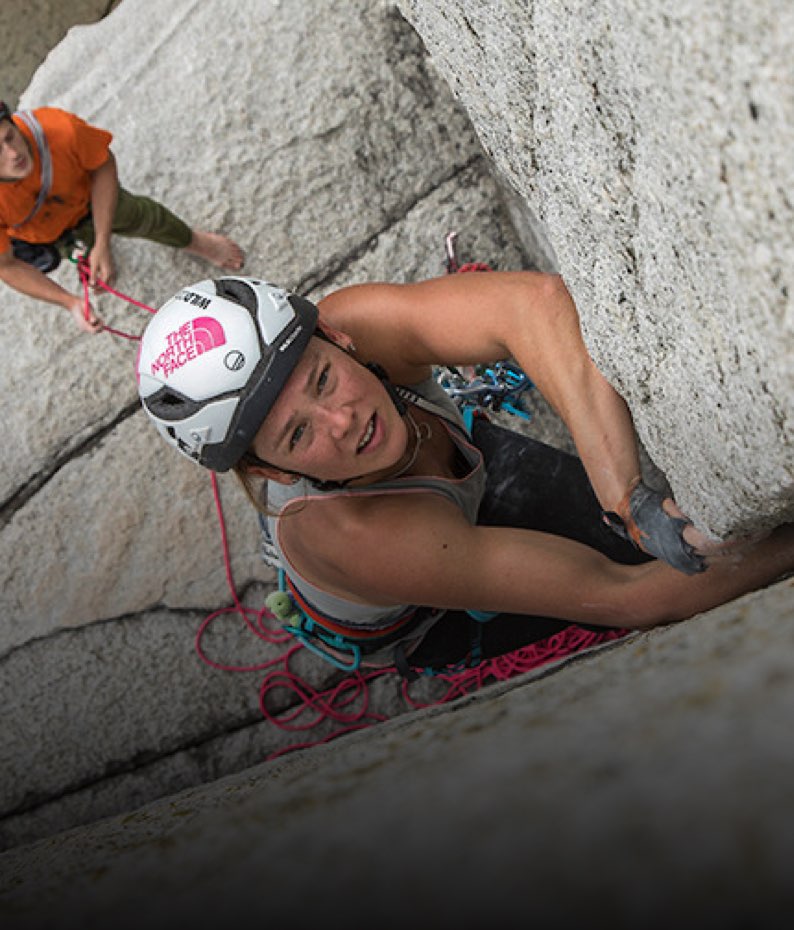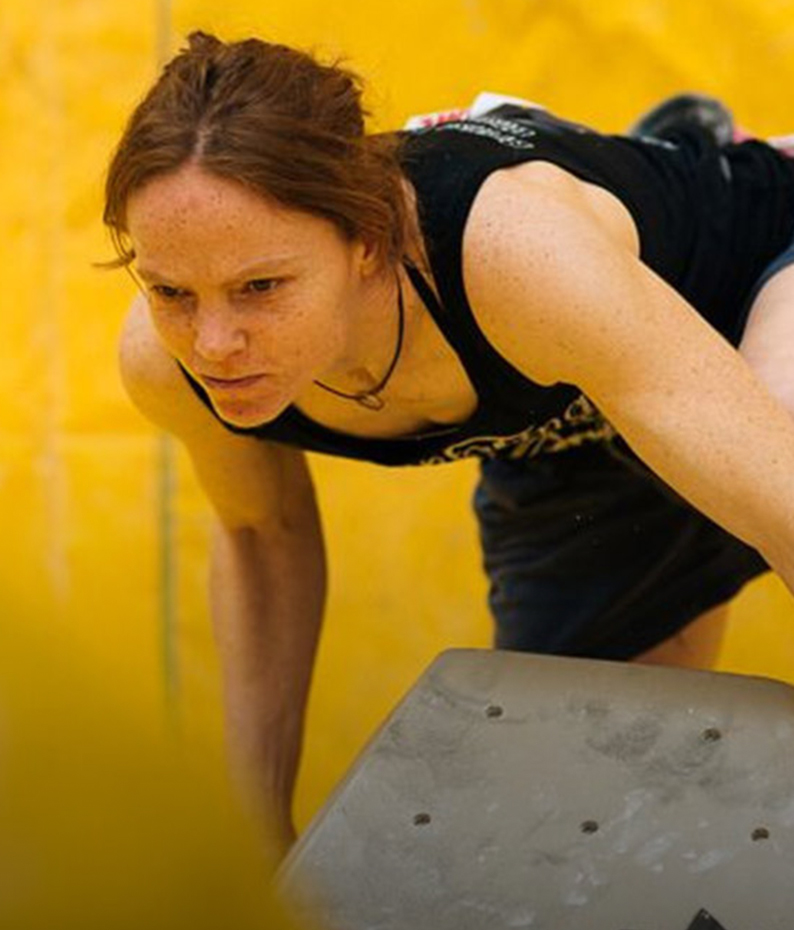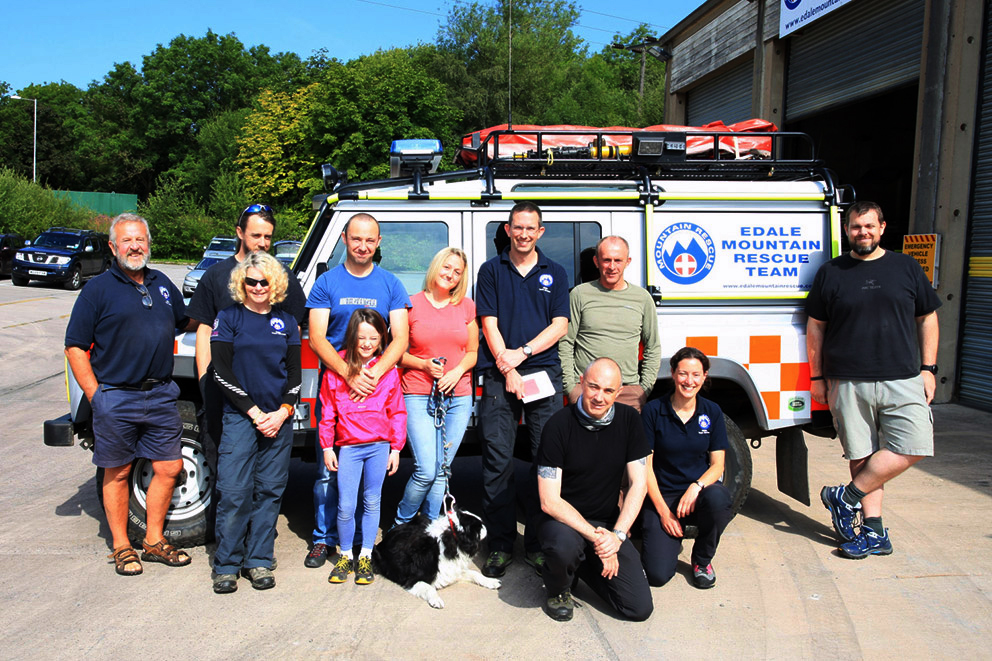Grimpeuses - Sognando L'Emancipazione
Caroline Ciavaldini condivide la propria motivazione nell'aiutare lo sviluppo di Grimpeuses: il primo Simposio internazionale delle Arrampicatrici
Costruire una comunità, le Olimpiadi e gli esempi da seguire
5 anni fa non ero molto interessata al “femminismo”.
Non pensavo di averne bisogno, non pensavo che essere donna facesse una qualsiasi differenza nella mia vita. Volevo migliorare il mio livello come scalatrice, e l'idea di un raduno con 400 donne per un giorno, non rivestiva un gran significato per me.
Poi sono stata invitata dal team del Simposio delle Donne Scalatrici per tenere un discorso all'evento. Ci andavo giusto perché mi pagavano, non mi aspettavo granché.
Ma, alla fine di quella giornata, potevo vedere 400 donne con il volto illuminato dal sorriso. Quella giornata le aveva motivate a scalare di più, a concentrarsi sui loro progressi e a spingere i propri limiti. Non riuscivo a spiegarmi come e perché, ma quel giorno era chiaramente accaduto qualcosa che mi aveva profondamente commossa.
Ho lasciato l'evento scherzando con le organizzatrici: “Quando ne farete uno in Francia?” Ma poi non ci ho pensato più. Ho fatto maturare l'idea ancora un po', prima di riconoscere l'importanza dell'evento. È stato andando a fare bouldering per una giornata con una squadra di 7 ragazze negli USA che ho sperimentato di nuovo quello spirito di puro cameratismo, senza emozioni negative, nessun bisogno di essere belle, nessun bisogno di sedurre, solo scalare insieme e incitarsi l'una con l'altra a dare il meglio... E allora ho deciso: organizziamo un simposio di donne scalatrici francesi, facciamo le “Grimpeuses” (francese per scalatrici).
La cosa si era messa in marcia, ma non avevo ancora le parole, i motivi precisati: perché volevamo un giorno senza uomini, che cosa dovevamo aiutare le donne a capire, esattamente? Così sono tornata da uno psicologo che era stato il mio allenatore mentale durante gli anni in cui gareggiavo; mi avrebbe aiutata a capire meglio tutto ciò, così che, quando mi avrebbero chiesto, senza lamentarsi: “Perché niente uomini?”, sarei stata in grado di formulare la mia motivazione in una risposta verbale.
Nel 2018, in Europa, le donne possono diventare presidenti. Possono diventare amministratori delegati, lavorare alacremente, guadagnare quanto un uomo. È una battaglia ancora in svolgimento, nel senso che, di sicuro non abbiamo un 50% di presidenti donne in Europa, ma oggigiorno la mentalità sta cambiando e, in alcune generazioni, potremo arrivarci. Le leggi comunque sono cambiate; si potrebbe anche affermare che quelle sulle pari opportunità stanno rendendo le cose “più difficili per gli uomini, più facili per le donne”, poiché a volte la competizione non risulta alla pari.
Ma questo è il punto, anche con tutte le leggi in vigore, le cose non cambiano all'istante, per il peso dovuto a cultura e storia.
"È chiaro che la storia ci mostra che donne e sport non vanno di pari passo"
Se guardiamo indietro alla storia dello sport femminile, in realtà non dobbiamo andare tanto lontano... Alle donne fu permesso di partecipare alle Olimpiadi soltanto nel 1900 (in un evento che risale all'epoca dell'antica Grecia!) e, in ogni caso, soltanto in poche discipline. Sport che erano definiti “compatibili con la loro femminilità e fragilità”, e persino ancora negli anni '60, solo il 20% dei partecipanti alle Olimpiadi erano donne. Nel 1972 alle donne fu consentito per la prima volta di gareggiare nelle maratone, cosa che richiese parecchie lotte; si credeva che correndo a lungo, gli organi riproduttivi femminili sarebbero caduti...
È chiaro che la storia ci mostra che donne e sport non vanno di pari passo. Tant'è che, anche oggi, c'è chi pensa e dice che i muscoli non sono un attributo femminile. Allora in che modo possiamo convincere una bambina che dovrebbe aspirare anche a essere forte?
Ora, se vogliamo preoccuparci per le donne e l'attività fisica, guardiamo i concetti di “avventura, pericolo, rischio”.
Storicamente non ci sono state grandi eroine, oppure solo di rado. Né condottiere, né grandi esploratrici. Si riteneva che le donne dovessero stare a casa a prendersi cura della famiglia. Le bambine degli anni '60 non avevano esempi femminili, oppure si trattava di Cenerentola, la Bella Addormentata e principesse varie... Ai maschietti non era “permesso” avere paura dopo una certa età... Per una bambina, invece, mostrare paura poteva risultare un vantaggio, un trucco per attrarre gli uomini. In che modo, quindi, possiamo motivare una donna a “puntare in alto o mollare”, scalare vie impegnative, accollarsi ardue imprese fisiche? Nessun'altra in famiglia ha fatto cose del genere prima di lei: né la mamma, le zie, le nonne, e la società non vedeva di buon occhio chi sfidava tali norme.
La storia è retaggio. Buono e cattivo. Nello sviluppo dell'alpinismo femminile, la storia ha evidentemente un contributo negativo. Ora che sappiamo che non esiste un gene del coraggio specifico al cromosoma Y, è tempo di prendere coscienza di quel retaggio negativo per poterlo sconfiggere.
Ho avuto la fortuna di essere invitata al mio primo simposio di donne scalatrici. Ha innescato una lunga riflessione che oggi mi aiuta ad affrontare nuove avventure, con tutte le scoperte che vi si accompagnano e tutta la gioia che mi donano. Spero di riuscire, anche se solo di poco, a far scattare nella mente delle donne la domanda: “Che cosa mi fa sognare?”, senza lasciarsi fermare da: “Che cosa mi spaventa?”
Arrivederci al prossimo Simposio delle Donne Scalatrici!
Vedi l'evento completo in Grimpeuses
Clicca per saperne di più sul Simposio delle Donne Scalatrici

1 ISLAND, 2 MONKS AND UNTOUCHED GRANITE
“Why did James and I pick a small dot on the other side of the planet?”
Because Yuji told us about it. The last time Yuji proposed us a trip, we ended up in Kinabalu, the now oh so famous mountain where untouched granite will overwhelm the climber. The Real Rock tour has thrown Kinabalu into fame, but 5 years ago, when we went there, no climber could even put it on the climbing
Kinkasan is a small island not far from Fukushima, on the north east side of Japan. It has 26km circumference and is inhabited by two monks. From Tokyo it is a six hour journey. Yuji didn’t say that much more: Kinkasan’s coast is covered with granite cliffs, and there is a Shinto shrine on it. Yuji mentioned as well the damages made by the tsunami…
We began our journey with next to no expectations about the climbing, and a big question mark for the rest. 3 days in the trip and I know exactly why we came: for Japan.
2 years ago we spent a week in this unique country and both James and I knew that we had to come back one day: how could I compare it? Well, the first time you taste wine, you have heard a lot about it. But you smell, and you only smell the alcohol, you taste and you can’t put words on it because wine is subtle, complicated and requests an education. You have to go back to it, learn to enjoy, differentiate and remember. Japan is maybe a little bit like wine.
There is this astonishing mix of modernity (the Japanese toilets and their multi jets, music and self cleaning options give you an idea of the immensity of your difference) and spirituality, respect, focus.
We arrived at Base Camp, the gym that Yuji opened 5 years ago in Tokyo, and I oscillate between marvel and shame. I am a pro climber, and most of the boulders are too hard for me, the Japanese climbers around me seem to evolve so effortlessly, like flying cats on the wall. But then you realise: the world championship have just finished in Paris and in the bouldering competition, 3 of the 6 medals are not only Japanese, but from Tokyo, from Base Camp. Yuji and his company helps the athletes become professional and they often climb together. Shall I repeat that? Half of the world’s medals come from one gym! Surely there is no wonder that Yuji owns that gym… But that is only just the very top of the iceberg, because behind this 3 medals, there are a lot of other athletes with an incredible level. I have never seen so many good, extremely good boulderers in one place. And I am a former competition climber, trust me, I know what I am talking about.
“Why are they so good?”
The answer is surely complicated but here are a few elements: climbing has become very trendy in Japan, with over a 100 gyms in Tokyo. The Japanese body type is perfect for climbing; light, powerful and explosive muscles. The Japanese constant pursuit of perfection pushes the athletes to train hard, just like everyone around them simply accomplished every task with perfection.
It was dry for the crossing, and after unpacking our bags at the shrine we bouldered on a nearby beach for 1 hour before the rain came. With so much rock to see and so little time, we hiked out anyway along the coast to search out potential lines. The rain became heavier, we became wetter, and after 4 soggy hours we returned to the shrine, hopes high but spirits low. We’d been preparing this trip since September 2015, putting the team together, finding funding from sponsors, organizing the local logistics, yet it would all be in vain if the weather didn’t brighten up.
A morning of rain gave us the excuse to sit down and record some interviews, though truthfully we had little to say as we’d done little climbing. Toru, ever the silent optimist finally dragged me out to the closest boulder spot during a break between two showers, and we were surprisingly able to climb! Toru lived up to his reputation of boldness and brilliance, making the first ascents of two of Kinkasan’s boldest and hardest problems. Finally things were looking up. The forecast was good for the following days, and group psyche could not have been higher. We began to plan our upcoming adventure and our first trip to the other side of the island – the area with the highest concentration of rock, and the biggest cliffs, but had to cut them short as bad news broke.
With my thirst for climbing temporarily quenched, we left the island in limbo, happy, yet sad, but knowing we’d be back in less than 24 hours. We passed the day visiting some of the worst tsunami affected towns in an effort to better understand what hardships the local people had to live through, and how they are moving forwards towards the future. It is one thing to watch the news from the comfort of your lounge back home, it is another thing entirely to see it first hand, and speak to the people who have lost everything - houses, possessions, loved ones!
Suddenly our troubles with the rain seemed embarrassingly small, and we remembered why we were actually here in the first place.
Our personal climbing desires must come second to the larger goal of showing this place to the world. Rain or shine, we have to get out there. Hike around, document the potential, and if in the end we are lucky, open up some new routes.

